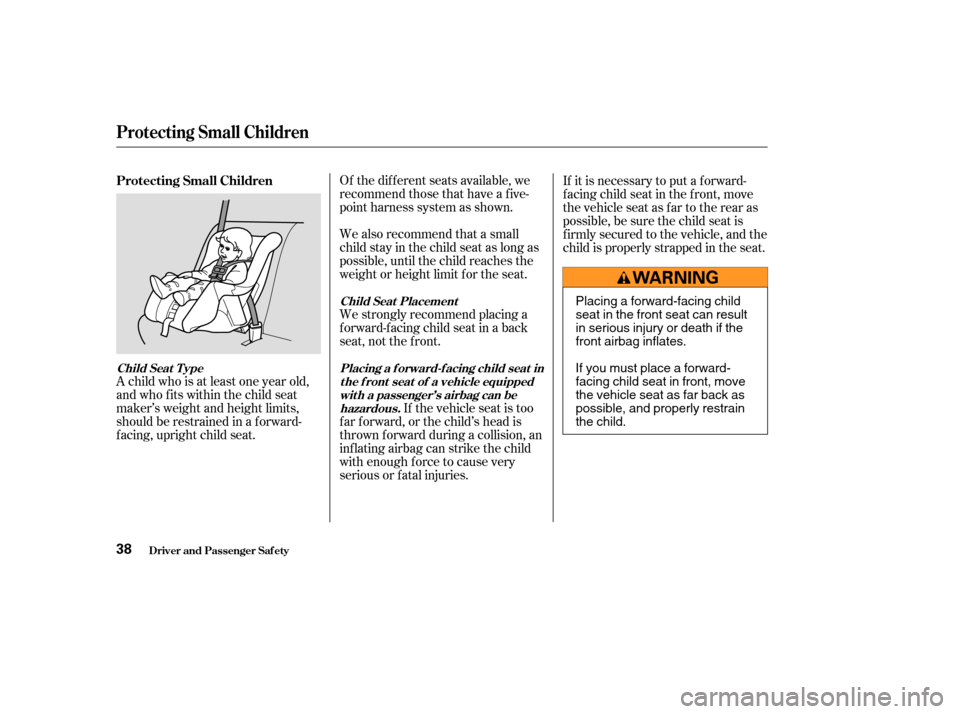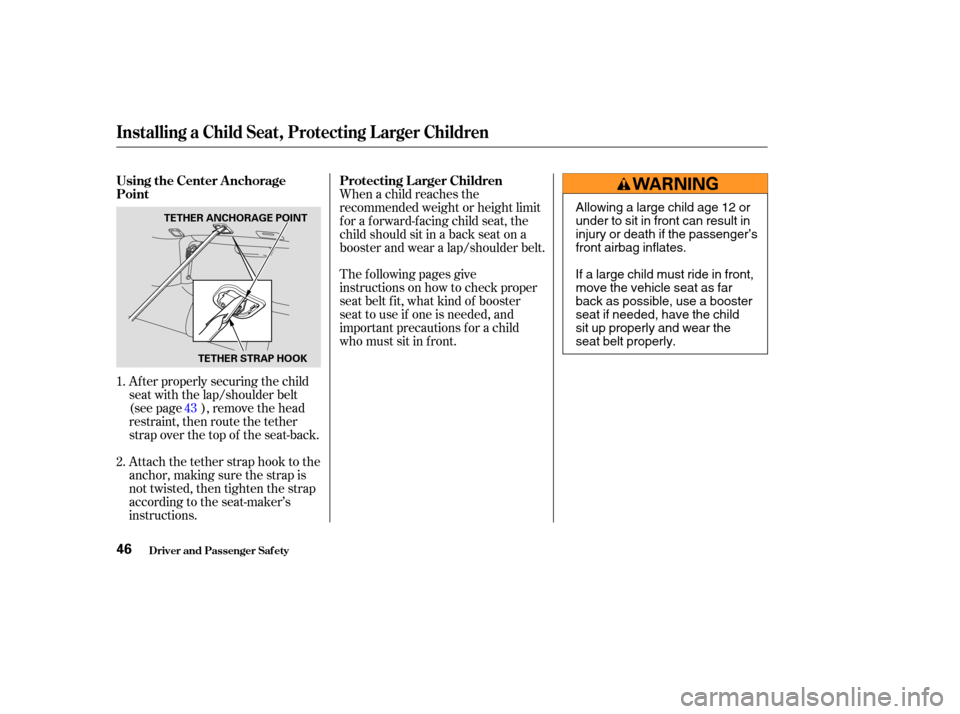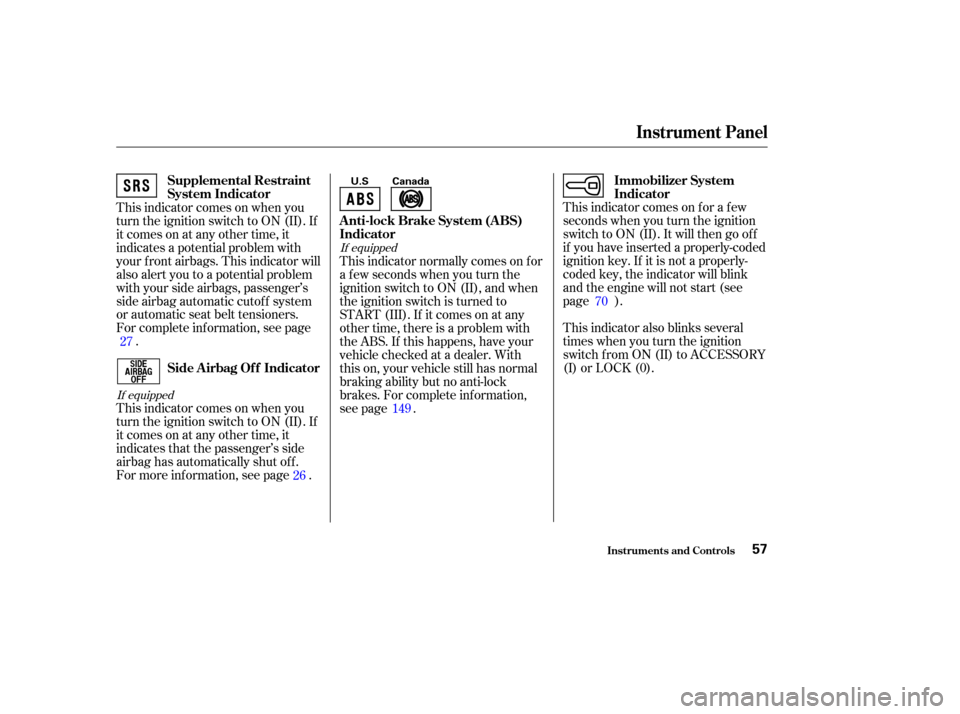Page 40 of 256
Only a rear-f acing child seat provides
proper support f or a baby’s head,
neck, and back.An inf ant must be properly
restrained in a rear-f acing, reclining
child seat until the child reaches the
seat maker’s weight or height limit
for the seat and the child is at least
one year old.
Two types of seats may be used: a
seat designed exclusively f or inf ants,
or a convertible seat used in the rear-
f acing, reclining mode.
If placed
f acing f orward, an inf ant could be
very seriously injured during a
f rontal collision.
Child Seat T ype Do not put a rear-f acing child seat in
a f orward-f acing position.
Protecting Inf ants
Driver and Passenger Saf ety36
Placing a rear-facing child seat
in the front seat can result in
serious injury or death if the
passenger’s front airbag inflates.
Always place a rear-facing child
seat in the back seat, not the
front.
Page 41 of 256
When properly installed, a rear-
f acing child seat may prevent the
driver or a f ront passenger f rom
moving the seat as far back as
recommended, or f rom locking the
seat-back in the desired position.
In either of these situations, we
strongly recommend that you install
the child seat directly behind the
f ront passenger seat, move the f ront
seat as far forward as needed, and
leave it unoccupied. Or you may wish
to get a smaller child seat that allows
you to saf ely carry a f ront passenger.
Never put a rear-f acing child seat in
the f ront seat. If the passenger’s
f ront airbag inf lates, it can hit the
back of the child seat with enough
forcetokillorseriouslyinjurean
inf ant. In this vehicle, a rear-f acing child
seatcanbeplacedinanyseating
position in the back seat, but not in
the front seat.Child Seat Placement
Protecting Inf ants
Driver and Passenger Saf ety37
Page 42 of 256

Of the different seats available, we
recommend those that have a f ive-
point harness system as shown.
A child who is at least one year old,
and who fits within the child seat
maker’s weight and height limits,
should be restrained in a f orward-
f acing, upright child seat. We also recommend that a small
child stay in the child seat as long as
possible, until the child reaches the
weight or height limit f or the seat.
If it is necessary to put a f orward-
f acing child seat in the f ront, move
the vehicle seat as far to the rear as
possible, be sure the child seat is
f irmly secured to the vehicle, and the
child is properly strapped in the seat.
We strongly recommend placing a
forward-facing child seat in a back
seat, not the f ront. If the vehicle seat is too
f ar f orward, or the child’s head is
thrown f orward during a collision, an
inf lating airbag can strike the child
with enough force to cause very
serious or f atal injuries.
Protecting Small Children
Child Seat T ype
Child Seat Placement
Placing a f orward-f acing child seat int he f ront seat of a vehicle equippedwith a passenger’s airbag can behazardous.
Protecting Small Children
Driver and Passenger Saf ety38
Placing a forward-facing child
seat in the front seat can result
in serious injury or death if the
front airbag inflates.
Ifyoumustplaceaforward-
facing child seat in front, move
the vehicle seat as far back as
possible, and properly restrain
the child.
Page 50 of 256

Af ter properly securing the child
seat with the lap/shoulder belt
(see page ), remove the head
restraint, then route the tether
strap over the top of the seat-back.
Attach the tether strap hook to the
anchor, making sure the strap is
not twisted, then tighten the strap
according to the seat-maker’s
instructions.When a child reaches the
recommended weight or height limit
for a forward-facing child seat, the
child should sit in a back seat on a
booster and wear a lap/shoulder belt.
The f ollowing pages give
instructions on how to check proper
seat belt f it, what kind of booster
seat to use if one is needed, and
important precautions f or a child
who must sit in f ront.
1.
2. 43
Using the Center A nchorage
Point
Protecting L arger Children
Installing a Child Seat, Protecting L arger Children
Driver and Passenger Saf ety46
TETHER ANCHORAGE POINT
TETHER STRAP HOOKAllowing a large child age 12 or
under to sit in front can result in
injury or death if the passenger’s
front airbag inflates.
If a large child must ride in front,
move the vehicle seat as far
back as possible, use a booster
seat if needed, have the child
sit up properly and wear the
seat belt properly.
Page 52 of 256

Some states also require children to
use a booster until they reach a
given age or weight (e.g., 6 years or
60lbs).Besuretocheckcurrent
laws in the state or states where you
intend to drive.The National Highway Traffic Safety
Administration and Transport
Canada recommend that all children
ages 12 and under be properly
restrained in the back seat.
If the passenger’s f ront airbag
inf lates in a moderate to severe
f rontal collision, the airbag can cause
serious injuries to a child who is
unrestrained, improperly restrained,
sitting too close to the airbag, or out
of position.
The side airbag also poses risks. If
any part of a larger child’s body is in
the path of a deploying side airbag,
the child could receive possibly
serious injuries.Of course, children vary widely. And
while age may be one indicator of
when a child can saf ely ride in the
f ront. There are other important
f actors you should consider.
To saf ely ride in f ront, a child must
be able to f ollow the rules, including
sitting properly, and wearing the seat
belt properly throughout a ride.
Booster seats can be high-back or
low-back. Whichever style you select,
make sure the booster meets f ederal
saf ety standards and that you f ollow
the booster seat maker’s instructions.
If a child who uses a booster must be
in front, move the passenger seat as
f ar back as possible and be sure the
child is wearing the seat belt
properly.
A child may continue using a booster
seat until the tops of their ears are
even with the top of the vehicle’s or
booster’s seat-back. A child of this
height should be tall enough to use
the lap/shoulder belt without a
booster. Physically, a child must be large
enough f or the lap/shoulder belt to
properly f it (see page ). If the seat
belt does not f it properly, with or
without the child sitting on a booster,
the child should not sit in the f ront.
47When Can a Larger Child Sit in Front
MaturityPhysical Size
Protecting L arger Children
Driver and Passenger Saf ety48
Page 56 of 256
On models without side airbagsOn models with side airbags
Saf ety L abels
Driver and Passenger Saf ety52
HOOD
RADIATOR CAP
Page 59 of 256
�Î
�Î
�ÎThe U.S. instrument panel is shown. Dif f erences f or the Canadian models are noted in the text.
Instrument Panel
Inst rument s and Cont rols55
LOW OIL PRESSURE INDICATOR
IMMOBILIZER
SYSTEM
INDICATOR
MALFUNCTION
INDICATOR
LAMP
CHARGING
SYSTEM
IND ICATOR
MAINTENANCE
REQUIRED INDICATOR HIGH BEAM
INDICATORDOOR-OPEN
INDICATOR
PARKING BRAKE AND BRAKE
SYSTEM INDICATOR LOW FUEL
INDICATOR
CRUISE CONTROL
INDICATOR
TAILGATE AND HATCH GLASS OPEN INDICATOR
SUPPLEMENTAL RESTRAINT SYSTEM INDICATOR
ANTI-LOCK BRAKE SYSTEM INDICATOR
(P.56, 213)
(P.57)
(P.214)
(P.56, 213)
(P.59) SEAT BELT REMINDER
INDICATOR
(P.58) (P.59)
(P.56) (P.58)
(P.
58)
(P.57)
SIDE AIRBAG OFF
INDICATOR
(P.59)
(P.57)
(P.57)
(P.56)
Page 61 of 256

This indicator comes on f or a f ew
seconds when you turn the ignition
switch to ON (II). It will then go of f
if you have inserted a properly-coded
ignition key. If it is not a properly-
coded key, the indicator will blink
and the engine will not start (see
page ).
This indicator also blinks several
times when you turn the ignition
switch f rom ON (II) to ACCESSORY
(I) or LOCK (0).
This indicator comes on when you
turn the ignition switch to ON (II). If
it comes on at any other time, it
indicates a potential problem with
your f ront airbags. This indicator will
also alert you to a potential problem
with your side airbags, passenger’s
side airbag automatic cutoff system
or automatic seat belt tensioners.
For complete inf ormation, see page
.
This indicator comes on when you
turn the ignition switch to ON (II). If
it comes on at any other time, it
indicates that the passenger’s side
airbag has automatically shut off.
For more inf ormation, see page . This indicator normally comes on f or
a f ew seconds when you turn the
ignition switch to ON (II), and when
the ignition switch is turned to
START (III). If it comes on at any
other time, there is a problem with
theABS.If thishappens,haveyour
vehicle checked at a dealer. With
this on, your vehicle still has normal
braking ability but no anti-lock
brakes. For complete inf ormation,
see page .
27
70
26 149
If equipped If equipped
Inst rument s and Cont rols
Supplemental Restraint
System Indicator
Anti-lock Brake System (ABS)
Indicator Immobilizer System
Indicator
Side Airbag Of f Indicator
Instrument Panel
57
U.S Canada